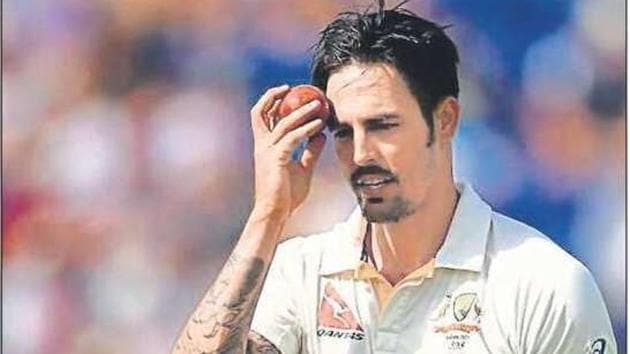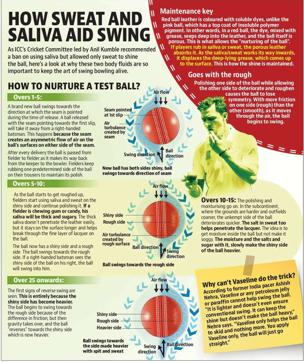Whole new ball game in art of swing
Cricketers won’t be able to use saliva to polish the ball, but sweat is equally potent. But why does the ball need to be shined at all?
Saliva is out. The International Cricket Council’s (ICC) Cricket Committee, led by Anil Kumble, recommended a ban on using saliva and allowed only sweat to shine the ball, as part of its guidelines to resume the game in the time of Covid-19. The logic is understandable—the use of spit can turn the cricket ball into a ‘fomite’, an object or material which may carry infection, since the virus spreads through saliva, and the ball changes hands between players all the time.

But why are these two bodily fluids so important to keep the art of swing bowling alive? What exactly do sweat and saliva do to the ball?
There is no scientific consensus on this, but based on experiential evidence as old as the game itself, here are some answers.

A plain sphere hurled through the air will have a pretty predictable trajectory. But the cricket ball is not a plain sphere; it has the seam protruding from the surface. How the bowler positions the seam during a delivery determines how the ball will move through the air.
Also Read | Delhi’s Feroz Shah Kotla ground turned into a COVID-19 centre
“When the ball is new and shining, the seam causes turbulence and it aids in conventional swing,” TA Sekhar, the former India pacer and who mentored several international bowlers at the MRF Pace Foundation, said. “It’s only one of the factors. The wrist and finger position, the point, direction and speed of release, the length…everything matters.”
As a match progresses, and the ball starts to go through wear and tear, the symmetry of the ball is further compromised. This is where sweat and saliva begin to play a critical role.
The ball begins to roughen up and lose its shine, which means there is a greater amount of friction working on it as it travels through the air. It also gets softer—both these things make the ball move slower through the air.
The bowling team picks one side of the ball to “nurture”. They apply sweat and saliva on this side and polish it. The leather on the ball is porous and is dyed with a grease-based paint. As the sweat/saliva is rubbed in, it displaces the deep lying grease, bringing it to the surface, and maintaining the shine. This is why it’s important to rub that side of the ball till it’s dry—it means that the sweat/saliva has permeated fully, and the grease that has risen has been distributed evenly. You also don’t want the ball to be wet, because that will only make it softer.
Also Read | Mohammad Kaif explains how Virat Kohli can be the most successful captain
“Having the ball dry is a primary condition in any kind of swing,” Madan Lal, World Cup-winning pacer and currently head of BCCI’s Cricket Advisory Committee, said.
Now what happens to the ball is this: it has a rough side, and a shiny side. Air moves differently along the two different surfaces—for one, there is less drag on the shiny side. The end result? The ball swings towards the rough side.
“It’s not as easy as it sounds,” Sekhar said. “It’s simply not spitting on a ball to shine. There are patches where the saliva is applied. There are designated players to maintain the ball.”
It needs plenty of experience to get good at ‘nurturing’ or ‘maintaining’ the ball. “You shine a new ball differently. When the ball is old and it is reversing. sometimes you put more sweat,” former India bowler Ashish Nehra told espncricinfo.in.
It (also) depends on the condition of the ball (how hard/soft/dry/wet/damaged it is), the make of the ball (SG, used in India, behaves differently to the English Dukes, which behaves differently to the Australian Kookaburra), and even the skill levels of the bowlers who will use the ball (do you have someone on your team who can reverse like Waqar Younis?).
“There are several different ways of shining the ball. Let’s say a Test match is on and the ball, SG Test, is semi-new, about 25 overs old. But it is not reversing and the ball has become a bit soft. Umpire is refusing to replace the ball. Now if you put too much spit on SG Test the ball gets more and more softer. Then you don’t get the zip as a fast bowler or even as a spinner.”
We’ve already jumped the gun and mentioned reverse swing, but that’s the next stage. When the ball is even older, and it has absorbed plenty of sweat and saliva on the shiny side, the shiny side gets heavier. Now the ball can get reverse swing. Which means, instead of moving towards the rough side, the ball will move towards the shiny side. Bowlers now have a wonderfully deceptive weapon.
A lot of effort goes into this, most of it illegal—cricket’s most intractable issue—ball tampering.
“Sometimes if a team is not getting wickets, it may want the reverse swing to start earlier,” Sekhar said. “So they would roughen one side secretly, and maintain shine on the other side. Generally the focus is more on the bowlers for ball tampering, not so much on others. Hence the ball changes so many hands.”
The favourite, because it is so hard to catch, is using saliva mixed with sugar from the gum or candy a player is chewing or sucking on. The sweetened saliva acts like a glaze.
The legal way out of it? Sweat.
“Sweat has salt and when applied on a particular side, it becomes heavier in that half and the ball tilts that way,” Lal said.




